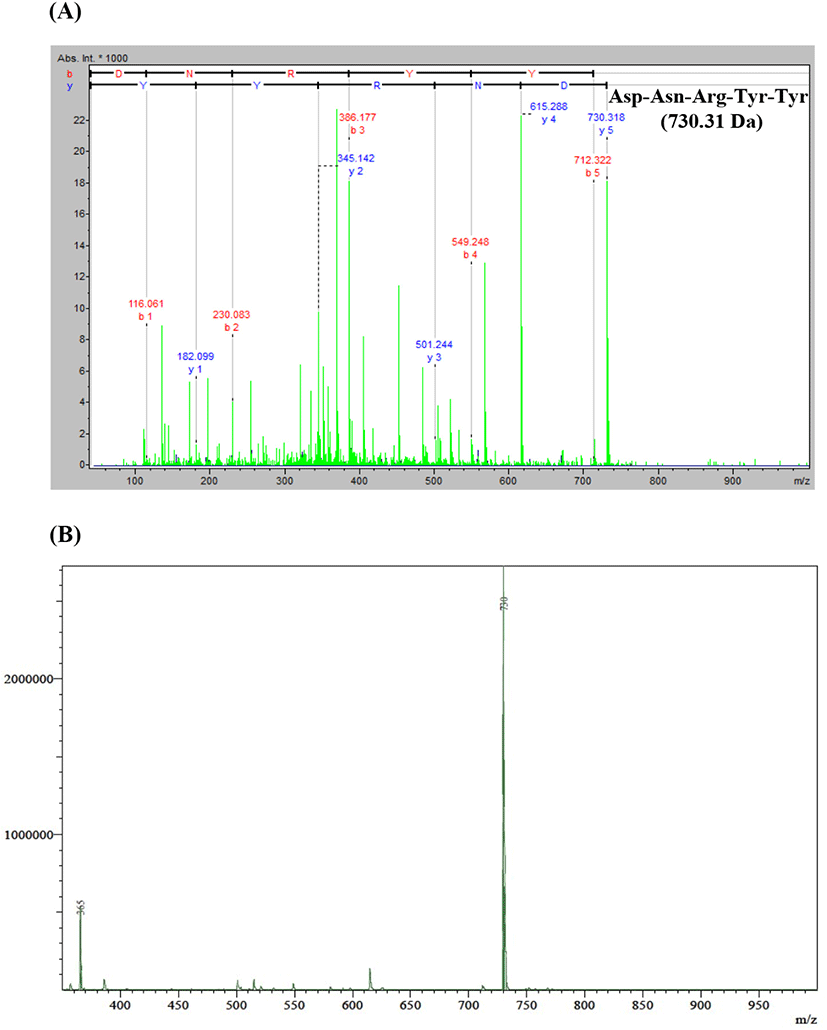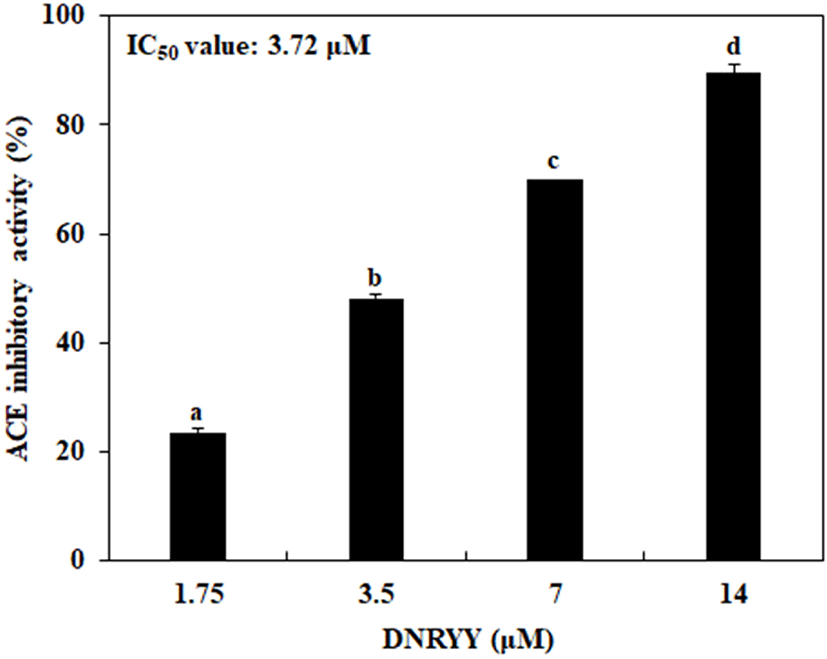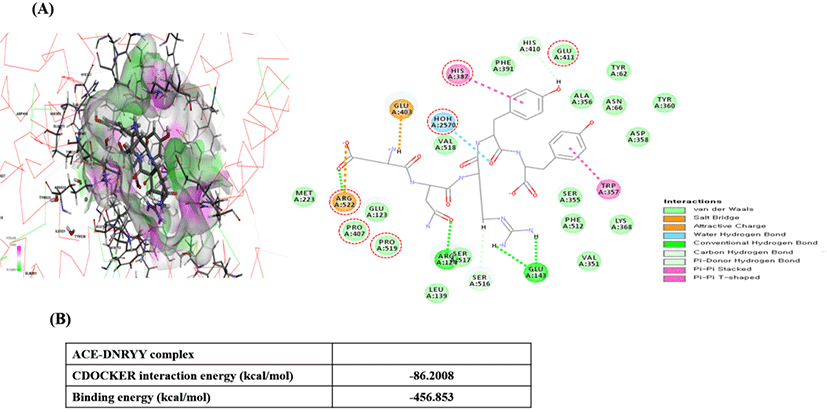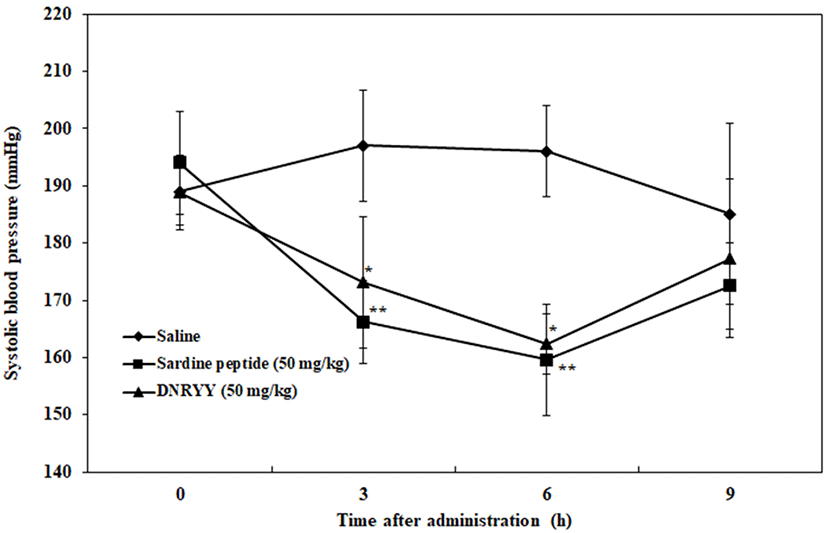Introduction
Hypertension is a severe chronic disease. It is the biggest contributor to stroke and coronary heart disease (Mills et al., 2020). Thus, hypertension is a major cause of premature death worldwide. Hypertension is regulated by several mechanisms including modulating of baroreceptor reflex, antidiuretic hormone, and renin-angiotensin-aldosterone system (RAAS) in human body (Brooks, 1997; Takahashi et al., 2011). Among these mechanisms, the RAAS is an essential factor of blood pressure regulation. It can increase blood volume and systemic vascular resistance (Pugliese et al., 2020). RAAS is mainly regulated through mediating bradykinin and angiotensin converting enzyme (ACE; Pugliese et al., 2020). ACE plays a critical physiological role in regulating blood pressure by converting angiotensin-I to angiotensin-II in the RAAS (Bernstein et al., 2014; Qian et al., 2019). Angiotensin II converted by ACE has many functions, including potent vasoconstriction action, release of antidiuretic hormone and aldosterone, and increased sodium reabsorption, thus increasing blood pressure (Bernstein et al., 2014; Chen et al., 2009; Qian et al., 2019). Thus, ACE inhibition activity is considered to be a major strategy in the prevention and treatment of hypertension (Lee and Hur, 2017; Miralles et al., 2018; Zhao et al., 2019).
Synthetic ACE inhibitor drugs such as enalapril, captopril, and benazepril have certain side effects such as headaches, insomnia, fatigue, and increased blood potassium levels (Lee and Hur, 2017). However, ACE inhibitors derived from natural products are stable and have minimal side effects compared with abovementioned synthetic ACE inhibitor. Therefore, over the last few decades, the discovery of natural ACE inhibitors has become a major research field (Chen et al., 2009; Iwaniak et al., 2014; Lee and Hur, 2017). Especially, ACE inhibitory peptides derived from various foods have gained increased research interest worldwide. Recently, many bioactive peptides with ACE inhibition activity have been successfully isolated from protein-rich foods (animal and non-animal protein sources; Lee and Hur, 2017; Miralles et al., 2018; Toldrá et al., 2020). It has proven that they can be used as potential functional food ingredients to prevent and improve hypertension (Gallego et al., 2018; Liao et al., 2021).
Velvet antler is called Nokyong in Korea. It has been used as a traditional medicinal ingredient of animal origin for over 2,000 years in Asia. It is still recognized as one of the powerful animal-based traditional medicine in pharmacopeias of Korea and China (Ding et al., 2019; Sui et al., 2014). Nowadays, in places such as East Asia, USA, Canada, and New Zealand, it is also used as a functional food ingredient and a health food supplement to prevent various diseases (Wu et al., 2013). Recently, numerous studies have reported that bioactive peptides and enzymatic hydrolysate derived from velvet antler show a various biological activities (Ding et al., 2017; Ding et al., 2019; Lee et al., 2015; Zhao et al., 2011; Zhao et al., 2016). However, as far as we know, there have been rarely reports about antihypertensive peptide derived from velvet antler by enzymatic hydrolysis used in this study. In our previous study, the peptide purified from alcalase hydrolysate of velvet antler was found to possess potent antioxidant activity through a peroxyl radical scavenging activity (Ding et al., 2019). However, the structure of the purified antioxidant peptide and its antihypertensive effects remain to be elucidated.
Therefore, the objective of the current study was to present the evidence for the antihypertensive effect of an antioxidant peptide purified from velvet antler alcalase hydrolysate, and verify its potential as a multi-functional bioactive peptide for use as a health food ingredient. Herein the present research investigated the structure characterization, ACE inhibitory activity, and potential interactions on ACE of the purified peptide. Furthermore, we have also investigated the antihypertensive action by oral administration in spontaneously hypertensive rats (SHRs).
Materials and Methods
Velvet antler collected from a farmed elk at 75 days after casting was obtained from Daesungsan Deer Farm (Daegwallyeong, Korea). Sliced fresh velvet antler was freeze-dried and ground into a fine powder.
To verify the antihypertensive effect of antioxidant peptide derived from velvet antler, separation and purification of antioxidant peptide were performed according to a previously reported method (Ding et al., 2019). Firstly, 10 g of the ground dried velvet antler powder was added into 1 L of distilled water. Alcalase enzyme (food-grade commercial proteases, Novo Nordisk, Bagsvaerd, Denmark) was then added with a substrate to enzyme ratio of 100:1. Enzymatic hydrolysis was conducted under optimal conditions (pH 8.0, 50°C) for 24 h, after which the hydrolysate was boiled at 100°C for 10 min to inactivate the enzyme. The hydrolysate was clarified by centrifugation at 3,000×g for 20 min to remove any unhydrolyzed residue. The supernatant of alcalase hydrolysate was filtered and adjusted to pH 7.0. The enzymatic hydrolysate was fractionated using ultrafiltration membranes (MWCO: 5 kDa) with a Millipore’s Lab scale TFF system (Millipore Corporation, Bedford, MA, USA) at 4°C. Then, <5 kDa fraction was obtained and lyophilized. The fraction (500 mg) was separated with ultrafiltration membranes and dissolved with 5 mL of filtered distilled water. This fraction was loaded onto a Sephadex G-25 column (2.5×100 cm) pre-equilibrated with filtered distilled water. Elution was then carried out with filtered distilled water at a flow rate of 1.5 mL/min. Absorbance of each fraction was measured at 220 nm and sub-fractions were collected. Lastly, the target fraction was then subjected to reverse-phase high performance liquid chromatography on an Atlantis T3 column (3 μm, 3.0×150 mm, Waters, New York, NY, USA) with a linear gradient of acetonitrile (0%–100% v/v, 30 min) at a flow rate of 1.0 mL/min. Elution peaks were detected at 220 nm. Finally, the antioxidant peptide was collected and lyophilized followed by identification of its amino acid sequences.
Molecular weight (MW) and amino acid sequences of the antioxidant peptide purified from velvet antler were determined using a MicroQ-TOFIII mass spectrometer (Bruker Daltonics, Bremen, Germany) coupled with an electrospray ionization (ESI) source. The purified peptide was dissolved in distilled water and infused into the ESI source. Its MW was determined by singly charged (M+H) state analysis in mass spectrum.
ACE inhibition activity of antioxidant peptide was measured using an ACE kit-WST (Dojindo Molecular Technologies, Kumamoto, Japan) in accordance with the manufacturer’s protocols. This ACE kit-WST assay is safe and simple. It provides highly reproducible data.
In order to assess the interaction between Asp-Asn-Arg-Tyr-Tyr (DNRYY) and ACE, molecular docking analysis were carried out using Accelrys Discovery Studio 3.5 (Accelrys, San Diego, CA, USA), according to a previously reported procedure (Kang et al., 2020). The crystal structure of ACE (PDB code: 1O86) was obtained from the Protein Data Bank (PDB, http://www.rcsb.org) and then molecular docking of DNRYY into the active site of the ACE was performed. The molecular docking runs were performed with the CDOCKER and Calculate Binding Energies tool. Docking of DNRYY to ACE was performed as follows: (1) a 2D structure was converted into a 3D structure; (2) proteins were prepared, and the binding site was defined; and (3) docking of compounds was performed using CDOCKER tool. The binding energy of the produced candidate compound-protein complexes were calculated using Calculate Binding Energies tool.
Anti-hypertensive effect in animal model was carried out in accordance with a previously reported method (Ko et al., 2012). Male SHRs (10 weeks of age) were purchased from SLC (Shizuoka, Japan). SHRs with tail systolic blood pressure (SBP) over 180 mmHg were randomly divided into three groups (n=6): Control group (saline); sardine peptide treated group (positive control); and the purified peptide treated group. Saline, sardine peptide, and the purified peptide dissolved in 1 mL saline were orally administered to SHRs at a dose of 50 mg/kg. SBP was measured with a tail-cuff method at 0, 3, 6, and 9 h post-administration using a CODATM blood pressure monitor (Kent Scientific, Torrington, CT, USA). The experimental protocol was approved by the Laboratory Animal Administration Committee of Jeju National University (Approval NO. 2017-0017). The experiment was conducted according to Animal Experimentation Guidelines of the University.
Results and Discussion
In our previous study, the IC50 value of the purified peptide from Alcalase hydrolysate of velvet antler against peroxyl radical was 0.343 mg/mL, suggesting that the purified peptide could possess potent antioxidant activity (Ding et al., 2019). As previous reported, MW and structure of the bioactive peptides is closely related to ACE inhibitory activity (Lee and Hur, 2017). However, the MW and amino acid sequence of the purified peptide have not been determined yet. Thus, in this study, amino acid sequence and MW of the purified peptide were determined using a Q-TOF ESI mass spectrometer. As shown in Fig. 1, the purified antioxidant peptide was identified as a pentapeptide DNRYY. The MW of this pentapeptide was 730.31 Da.

Antihypertensive effect is the most extensively studied bioactivity in relation to food-derived peptides. They main mechanism of action is based on the inhibition of the ACE that converts the inactive angiotensin I into the potent vasoconstricting angiotensin II (Miralles et al., 2018). Angiotensin II produced by the action of ACE also amplifies oxidative stress by inducing the formation of intracellular reactive oxygen species (Del Pino-García et al., 2017; Kang et al., 2020). Thus, ACE inhibition intensifies the antioxidant defense system in humans. Several food-derived bioactive peptides have been reported to possess both antioxidant and antihypertensive effects (Kang et al., 2020; Toldrá et al., 2020). Therefore, we investigated to provide evidence for the antihypertensive effect of an antioxidant peptide purified from velvet antler alcalase hydrolysate in the present study. In order to validate the antihypertensive effect of the purified antioxidant peptide (DNRYY), we evaluated the inhibitory activity of DNRYY against ACE. As shown in Fig. 2, DNRYY inhibited ACE activity in a dose dependent manner. At concentrations of 1.75, 3.5, 7, and 14 μM, it inhibited ACE activity by 23.56%, 48.11%, 69.83%, and 89.53%, respectively. IC50 values of DNRYY against ACE was 3.72 μM. Findings of this study exhibited that DNRYY might be useful as an effective velvet antler-derived antihypertensive peptide. The structure of a peptide is an important factor for its ACE inhibitory activity (Lee et al., 2009; Lee et al., 2014). As reported previously, aromatic amino acids at the C-terminus, hydrophobic amino acid residues at the N-terminus, and positively charged amino acids at the middle in peptide structure play an important role in the ACE inhibition activity of peptides (Cushman and Cheung, 1971; Welderufael et al., 2012; Wu et al., 2016). Especially, it has been proven that peptides with C-terminal Tyr residues such as Val-Tyr, Met-Tyr, Ile-Tyr, and Arg-Val-Tyr show potent ACE inhibitory activities (Chen et al., 2009; Erdmann et al., 2006; Ko et al., 2012; Liu et al., 2021; Yu et al., 2019). In this study, the identified pentapeptide contained Tyr at the C-terminal, which might have contributed to its ACE inhibition activity. This study provides strong evidence for ACE inhibitory activity of antioxidant peptide purified from velvet antler alcalase hydrolysate. Results of preceding studies and the present study demonstrated that the purified peptide had both antioxidant and antihypertensive effects.

Molecular docking is an application wherein molecular modeling techniques are used to predict how a protein (enzyme) interacts with small molecules (ligands; Ko and Lee, 2021). The application of in silico molecular docking tools can simplify process and cut down costs for discovery of bioactive peptides, and illuminate the action mechanism (Fan et al., 2020; Zhao et al., 2019). In the present study, in order to understand potential molecular interactions between the velvet antler-derived pentapeptide (DNRYY) structure and specific amino acids at the binding site of ACE, computational molecular docking of the DNRYY into the binding site of ACE (PDB code: 1O86) was conducted using Discovery Studio 3.5 (DS). As shown in Fig. 3A, the complex of ACE-DNRYY binding sites was predicted by the 2D diagram. DNRYY formed five hydrogen bonds with amino acid residues in ACE: One with HOH2570, one with ARG522, one with ARG124, and two with GLU143. DNRYY also formed two pi interactions with HIS387 and TRP357 residues in ACE. Additionally, DNRYY interacted with the GLU403 (attractive charge) and ARG522 (salt bridge) amino acid residues through electrostatic interactions. These results suggest that DNRYY can interact with amino acids residues of ACE and inhibit ACE activity. Pi interactions and hydrogen bonds in ACE-ligand interactions are known to contribute to ACE inhibition activity (Fu et al., 2017; Ling et al., 2018; Tu et al., 2018). It has been reported that food-derived bioactive peptides have strong interactions with ACE by forming high numbers of pi interactions and hydrogen bonds with ACE amino acid residues, thus effectively inhibiting ACE (Chamata et al., 2020; Fan et al., 2020; Ko et al., 2017). The present study also showed that DNRYY could form high numbers of pi interactions and hydrogen bonds with ACE amino acid residues. Accordingly, our results suggest that the potent ACE inhibitory activity of DNRYY can be attributed to high numbers of hydrogen bonds and pi interactions at the ACE binding site. The docking of stabilized poses of ACE-DNRYY complex was obtained from DS 3.5 binding energy program. Binding energy value was –86.200 kcal/mol for CDOCKER interaction energy and –456.853 kcal/mol for binding energy. These results indicate that DNRYY has a good and stable binding affinity with ACE. Overall, the docking results provide strong evidence for the ACE inhibition activity of DNRYY.

ACE-inhibitory peptides derived from foods have gained interest as potential hypertension treatment agents. Several studies have reported that bioactive peptides exhibited significant blood pressure lowering effect by inhibiting ACE activity in vivo studies using SHRs (Lee and Hur, 2017; Miralles et al., 2018; Toldrá et al., 2020). Thus, to verify the in vivo antihypertensive effect of ACE inhibitory peptide (DNRYY) derived from velvet antler alcalase hydrolysate, the ACE inhibitory peptide was evaluated by measuring changes of SBP at 3, 6, and 9 h after oral administration of 50 mg/kg of body weight to SHRs. The SBP reduction effect of DNRYY was compared with effects of a sardine peptide, a commercially available antihypertensive peptide (derived from Sardinops melanostictus) used in blood pressure lowering functional food ingredient in Korea and Japan. As shown in Fig. 4, the saline administrated group exhibited slight changes in SBP in the range of 185–197 mmHg. However, at 3 h after oral administration of DNRYY, SBP was significantly decreased compared to that in the saline group. The DNRYY administrated group showed a similar SBP reduction to the sardine peptide administrated group with activities maintained until 6 hours. These results clearly show that oral administration of purified peptide (DNRYY) can decrease SBP significantly in SHRs. Previous many studies have revealed that food-derived peptides consisting of Tyr at the C-terminus, such as Val-Tyr, Met-Tyr, Arg-Val-Tyr, Ile-Tyr, and Val-Glu-Gly-Tyr show antihypertensive effects in SHRs through ACE inhibition activity (Ko et al., 2012; Matsui et al., 2004; Tanaka et al., 2006). Accordingly, the antihypertensive effect of DNRYY in SHRs can be attributed to its ACE inhibition activity. These results of this study confirmed that this ACE inhibitory peptide from velvet antler alcalase hydrolysate could effectively reduction of blood pressure.

Conclusion
In this study, the structure and antihypertensive effect of an antioxidant peptide derived from Alcalase hydrolysate of velvet antler were investigated. The identified pentapeptide (DNRYY, 730.31 Da) was demonstrated to be a great ACE inhibitory peptide based on ACE inhibition activity assay and in silico molecular docking analysis. In addition, oral administration of this pentapeptide significantly reduced SBP in SHRs. These results suggest that the antihypertensive effect of this pentapeptide might contribute to inhibition of ACE. Therefore, this ACE inhibitory peptide derived from velvet antler is a multiple bioactive peptide with potential applications as animal-based functional food ingredients and health food supplement. Nevertheless, gastrointestinal digestion by oral administration of bioactive peptides have demonstrated to affect the physiological action and, therefore, should also be considered. Therefore, further investigations are needed on the resistant to gastrointestinal digestion of ACE inhibitory peptide derived from velvet antler.













